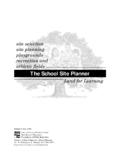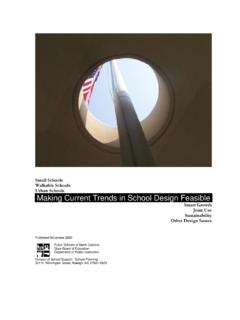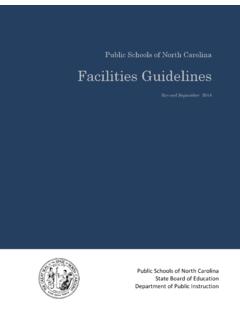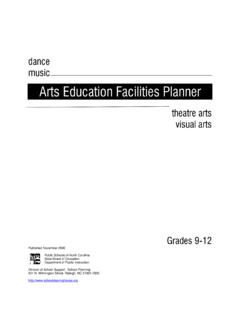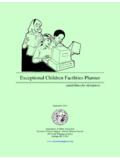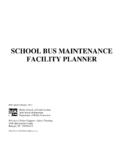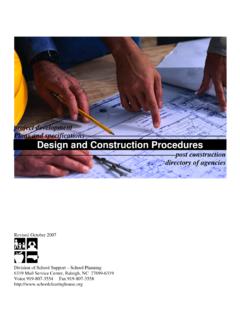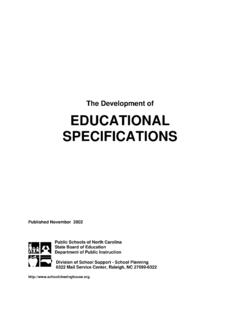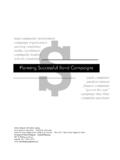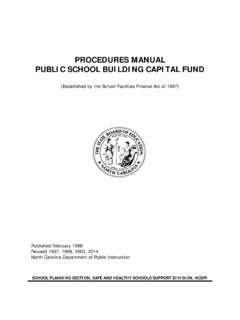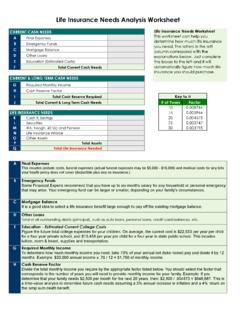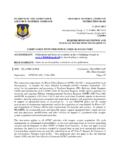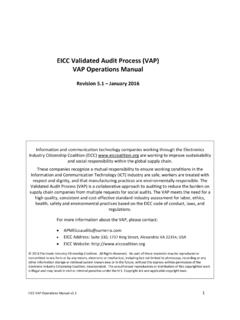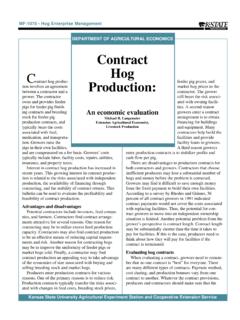Transcription of School Closing Procedure - schoolclearinghouse.org
1 Public Schools of North Carolina State Board of Education Department of Public Instruction Financial and Business Services Division of School Support School Planning Section School Closing Procedure Relating to the Public Schools of North Carolina February - 2008. In compliance with federal law, including the provisions of Title IX of the Education Amendments of 1972, NC. Public Schools administers all state-operated educational programs, employment activities and admissions without discrimination because of race, religion, national or ethnic origin, color, age, military service, disability, or gender, except where exemption is appropriate and allowed by law. Acknowledgments The Department of Public Instruction gratefully acknowledges the contributions of the following, without which the development of this publication would have been difficult. Kenneth Phelps, Architect / School Planning Consultant, School Planning Section, Department of Public Instruction, Raleigh, NC.
2 Primary author for this publication. Steve Taynton, AIA, Chief, School Planning Section, Department of Public Instruction, Raleigh, NC. Roger Ballard, AIA, Consulting Architect, School Planning Section, Department of Public Instruction, Raleigh, NC. Bob Bryan, , Consulting Engineer, School Planning Section, Department of Public Instruction, Raleigh, NC. Long Chang, , Consulting Engineer, School Planning Section, Department of Public Instruction, Raleigh, NC. Johnny Clark, Consulting Engineer, School Planning Section, Department of Public Instruction, Raleigh, NC. Greg Flynn, Consulting Architect, School Planning Section, Department of Public Instruction, Raleigh, NC. Pam Ray, Program Assistant, School Planning Section, Department of Public Instruction, Raleigh, NC. 2. School Closing Procedure North Carolina Department of Public Instruction School Planning Section The following Procedure is intended as a guide to be used when School Closing is contemplated, and upon which local board policy may be based.
3 The Procedure is presented in a sequential manner; however, its sections may be used separately or together as local conditions require. It is primarily intended to identify the various kinds of information to be considered, as well as the particular processes to be undertaken by the local board of education prior to Closing a School . Publications of the School Planning Section, referenced herein, may be accessed at the website, General Statutes Whenever it is contemplated that a School may be closed, the local board of education should review, with an attorney, the applicability of General Statutes 115C-72 and 115C-518(a) to the proposed action, as well as the applicability of other statutes. Evaluation of Facility A facility evaluation shall be undertaken when it is apparent that physical condition will influence the decision to close a School . The evaluation should be performed by an individual qualified to make technical judgments, such as an architect, engineer, or other appropriate consultant.
4 A report should be submitted to the local education agency (LEA) superintendent, properly identifying the general condition of the facility and detailing any special problems relating to age, adaptability to Educational Program needs, North Carolina Building Code violations, the structure, or the utility systems. The report should include an estimate of useful life expectancy and, in particular, an accounting of repairs to be made if the facility is continued in service. (Some schools may be closed regardless of age and condition.) It may be beneficial to refer to the Feasibility and Cost Analysis Form published by School Planning Section, NCDPI, at . Capacity of Facility Useful capacity may be calculated in terms of the numbers of students the facility can accommodate, using formulas approved by the local board of education. Each local board of education will determine its own formula for capacity calculation. Some suggested methods to determine capacity are as follows: Capacity may be determined by multiplying the pupil-teacher ratio established by the board of education by the number of classrooms.
5 Capacity may be determined by dividing the square footage in an instructional area by the per-pupil square footage recommended for the purpose for which it is used. Capacity may be determined through the standard Procedure of the School Planning Section, DPI, using the School Capacity Worksheet provided on the website, at 3. The capacities calculated may not exceed the class-size limits mandated by the General Statutes. Membership Present and projected membership should be a necessary part of any decision to close a School . The local board of education should calculate pupil population projections for a period of time beyond the year the School Closing is considered normally a minimum of five years so that the decision will not be adversely effected by normal fluctuations in the population. This should be done for the School system as a whole, all schools included. See, for example, the 10-Year ADM Growth Projections (a summary for each LEA), and ADM Growth Analysis (with details for each grade level), both available from School Planning.
6 These are reports of statistical calculations, and do not account for local variances caused by manufacturing plants opening or Closing , or similar influences. The local board should be aware of two other factors in projecting membership. They are (1). the relationship between increases or decreases in the general population and School membership, and (2) the need to project membership in a given attendance area where it is anticipated that a School may be closed. It could be appropriate for the local board of education to create a policy that any School whose membership falls below a certain number ( , 100) will be closed after due process, and all pupils and School personnel reassigned. The board may, of course, choose its own minimum membership number. Organization of the School System Any proposal to close a School should address the operational needs of the School system, to focus on the possibility of reorganizing the School rather than Closing it.
7 For example, a change from the traditional Grade 6-8 Middle School to a K-5 Elementary School may prevent a sound facility from being removed from service. Even adding or removing grades at the elementary level may permit a facility to continue in service. Every five years, all local boards of education are required by 115C-521(a) to submit a Facility Needs Assessment (Long Range Plans) to the State Board of Education. The results of this survey will assess projected facility needs for the next 5-10 years. Current tabulations of the results can be viewed at Facility Needs Survey, published by School Planning. It will, therefore, be expedient for the local board of education to understand the long-range programmatic needs of the School system before deciding to close a School . It may be appropriate to close a School for some temporary purpose which, in the final analysis, will serve the long-term goals of the School system. Organization should be examined in light of solidly established purposes.
8 Costs of Operation For the local board to be justified in its assessment to close a School , it must calculate the financial costs of operating the facility and, more especially, the funds to be saved by Closing the facility. These costs may be compared to per-capita costs of operating other similar 4. schools, to determine the savings (if any) of educating the displaced student body at another site. These financial assessments normally include, but are not restricted to, the areas of (1). personnel reassigned or eliminated, (2) utilities for a designated time period, such as a year, (3) maintenance and repair costs per year, (4) custodial costs per year, (5) transportation costs, and (6) insurance costs. If the facility is to be closed and not replaced, a substantial capital outlay may be avoided. Transportation It is not always possible to realize cost savings in transportation by Closing a School , since reassignment of pupils sometimes increases transportation responsibilities.
9 However, this aspect must be included in the decision to close or not to close. Specifically, rerouting buses and the effect upon time and distance should be examined. There may be a need for fewer buses, or additional buses. Maintenance costs, number of drivers needed, economy of routing, etc. should be assessed. Diversity Local School boards recognize that diversity is a sensitive factor in School enrollment. No School board should take an action which so seriously affects pupil assignment as does Closing a School , without being completely aware of its ramifications on diversity. The probability is that diversity alone will not determine whether or not a School is closed;. however, it is an important matter that should not be overlooked. Alternative Uses The total program needs of the School system should be examined before a conclusion is reached that a closed School has no useful alternative purpose which is compatible with the mandate of the local board of education to teach children.
10 Instructional programs as well as auxiliary services should be examined. A number of possible alternatives suggest themselves. They are (1) special education, (2). special purpose schools, (3) social and community purposes, (4) maintenance and repair services, (5) storage, and (6) office space. Current expense and capital outlay costs always ought to be included in any assessment of alternative uses. Program Considerations Before Closing a School , the local board of education should understand where students will be reassigned and what effect Closing will have on program opportunity, resulting from staff reassignments and the reallocation of resources. Tentative Decision After the local board of education carefully studies the facility evaluations, facility capacity, School membership, School organizations, costs of operation, effect on transportation, alternative uses for the facility, effect on diversity, and effect on local governmental planning, the board should make a tentative decision.
